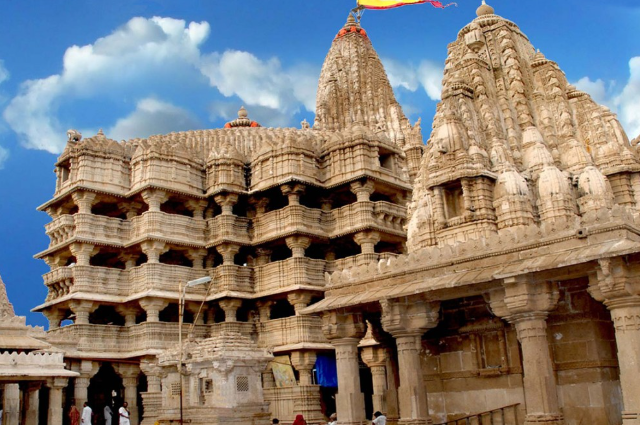
The Saurashtra kingdom was one among the many kingdoms ruled by Yadava kings in central and western India. Other in this group include Cheri kingdom, Dasarna kingdom, Surashena kingdom or Vraja kingdom, Karusha kingdom, Kunti kingdom, Avanti kingdom, Malaya kingdom, Gurjara kingdom, Ananta kingdom, Dwarka kingdom, Heheya kingdom, and Vidharbha kingdom.
Saurashtra, now renamed as Gujarat, figures in the Puranic literature and the epics. The regions of north Gujarat are also known as Anarta after Sharyati’s son. Anarta’s son, Revati, rules Kushthali, the present Dwarka, which was the capital of Anarta. The river Narmada is also known as Reva after a descendant of Revat by the same name. Mount Girnar is also known as Raivataka, which is also derived from regavat. It is roughly the southern Gujarat, including the peninsular region. The name Surat, a modern city of Gujarat, is derived from the name Saurashtra. The peninsular region forming the southern Gujarat is still known as Saurashtra. During the Mahabharata period, they were in their migratory phase from Mathura to Dwaraka. In the epic Mahabharata, they were mentioned as Gopa rashtras and as Gopas. They have participated in the Kurukshetra war, siding the Duryodhana, though they had close kinship with Vasudeva Krishna Gurjaras or Gujjars. Later inhabited the eastern valley of the Aravalli range in Rajasthan.
Lord Sri Krishna, the hero of the puranas, the author of Srimadbhagavadgita, and one of the most endearing, colourful, and Loving gods of Hinduism, left Mathura along with his maternal grandfather Ugrasen and with his clan, members of the Yadavas, and settled down in Saurashtra near its coast. Lord Sri Krishna carried the banner of the Aryan culture over a large tract covering the whole of Gujarat and beyond. He fortified the ancient Kushtali, which later became famous as Dwarka, meaning gateway to heaven. Lord Sri Krishna’s elder brother, Sri Balaram, got married to Revati, the daughter of Kukudmi of the Reva dynasty. Vararjanabh, the son of Aniruddha and grandson of lord Sri Krishna from the Vrishnukul branch of the Yadavas, was the only survivor of the mutual Parv internecine strife among the Yadavs. Arjuna, the famous character of the Mahabharata, crowned Vajranabh as the ruler of Mathura, and with that came to an end of Yadav dynasty’s sway over Saurashtra.
In the Mahabharata, the Saurashtra region is mentioned as part of the larger narrative of the Indian subcontinent during the Vedic period. It’s referenced in various contexts, including as the kingdom of the Yadavas, particularly under the rule of Krishna, who is said to have settled in the city of Dwaraka, located in modern-day Gujarat. Dwaraka, also known as Dwaravati, is believed to have been one of the capitals of the ancient Saurashtra kingdom during the Mahabharata era. This epic describes the events surrounding Krishna’s life and his interactions with various kingdoms, including those in the Saurashtra region. The Mahabharata provides insights into the political landscape and cultural milieu of ancient India, including the Saurashtra kingdom.
Saurashtra is the southern peninsula of the current Gujarat state of India. It means the land of a hundred kingdoms. Sau hundred and rashtra kingdom/country.
The Yadavas, particularly under the leadership of lord Krishna, are traditionally believed to have ruled over the Saurashtra region, with Dwaraka as their capital. According to Hinduism, and ancient texts like the Mahabharata, Krishna ruled a kingdom in Dwaraka that was prosperous and influential. The Yadavas were a prominent clan, and their rule over Saurashtra us an integral part of the region's history and cultural heritage. Dwarka was established as the capital of Saurashtra by the aryans during the Puranic period. The Yadavas, who had migrated from Mathura, established their kingdom here when the city was known as Kaushathali. It was during the period that the city underwent rebuilding and was named Dwarka friendly population of natives also prompted Krishna to settle at Dwarka when he decided, after fighting Jarasandha, the king of Magadh, to retreat from Madhura. The kingdom, also known as the Yaduvanshi Empire.
Sabha Parv
And the prince, after this, with great efforts, brought Akriti, the king of Saurashtra and preceptor of the Kaushika, under his sway. The virtuous prince, while staying in the kingdom of Saurashtra, sent an ambassador to King Rukmin and Bhishmika within the territories of Bhojakata.
Bhishma Parv
The large force, which was well protected by mighty car warriors of the Vrishul and Bhoja races, was also led by the warriors of Surashtra, well armed and well acquainted with the uses of weapons, and which was led by Kritivarman, proceeded towauth of the army.
Ashwamedha Parv
Arjuna protected the country of Saurashtra, his forces guided by the horse. He arrived at Gokarna he repaired thence to Prabhas.
Udyog Parv
O slayer of Madhu, well known are those eighteen kings that annihilated their kingsmen, friends, and relatives. Even as when dharma became extinct Kali was born into asuras, flourishing with prosperity and blazing with energy, so was born udavarta among the haihayas, Janamejaya among the nipas, Vahula among the talajhangas, proud vasu among the krimis, ajavindu among the valihas, rushardhik among the saurashtras, arkaja among the valihas, dhaumualaka among the chinas, hayagriva among the videhas, varayu among the mahaujasas, Vahu among the Sundaras, pururavas among the diptakashas, sahaja among the chedis and the matsyas, vrishaddhaja among the praviras, dharana among the Chandra batsyas, bighana among the mukhtas and Sama among the Nandivegas.
Vana Parv
By performing austerities on the sacred hill of Ujjayanta is saurashtras that abounds in birds and animals, a person becomes regarded in heaven.
References
